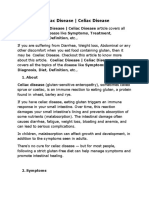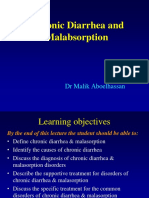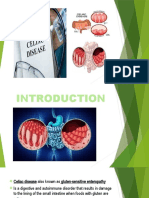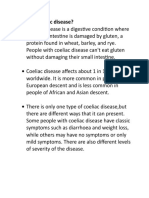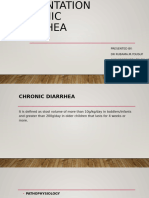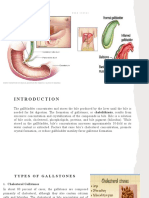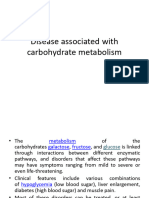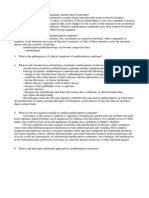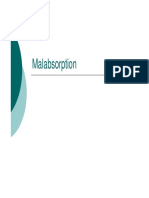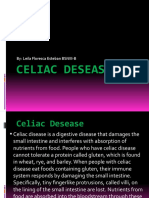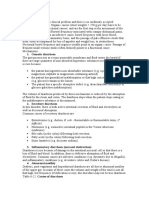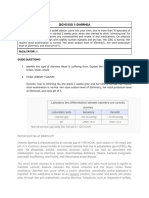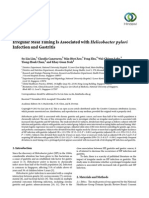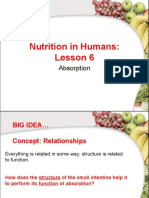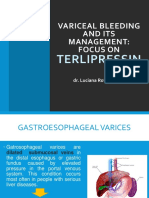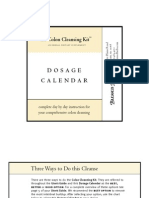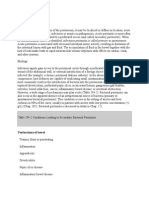0 ratings0% found this document useful (0 votes)
2 viewsGid 3
Gid 3
Uploaded by
BADE RUCHITHACopyright:
© All Rights Reserved
Available Formats
Download as PPTX, PDF, TXT or read online from Scribd
Gid 3
Gid 3
Uploaded by
BADE RUCHITHA0 ratings0% found this document useful (0 votes)
2 views22 pagesOriginal Title
GID 3
Copyright
© © All Rights Reserved
Available Formats
PPTX, PDF, TXT or read online from Scribd
Share this document
Did you find this document useful?
Is this content inappropriate?
Copyright:
© All Rights Reserved
Available Formats
Download as PPTX, PDF, TXT or read online from Scribd
Download as pptx, pdf, or txt
0 ratings0% found this document useful (0 votes)
2 views22 pagesGid 3
Gid 3
Uploaded by
BADE RUCHITHACopyright:
© All Rights Reserved
Available Formats
Download as PPTX, PDF, TXT or read online from Scribd
Download as pptx, pdf, or txt
You are on page 1of 22
Celiac Disease, Lactose
Intolerance & Diverticular
Disease
Celiac Disease
Gluten-sensitive enteropathy or, as it is
more commonly called, celiac
disease, is an autoimmune
inflammatory disease of the small
intestine. It is precipitated by the
ingestion of gluten, a component of
wheat protein-gliadin, in genetically
susceptible persons. A defect in the
enzyme system that splits this
protein fraction along with atrophy
of jejunal mucosa may be the
specific cause for celiac disease. It
usually develops within the first
three years of life.
Symptoms:
Child with celiac's disease fails to thrive, losses appetite and has a
potbelly. Stools are large, pale and offensive due to the presence of
fat in the form of fatty acids. Anaemia is present with symptoms of
paleness, fatigue, tachycardia (fast pulse). The microscopic section of
the villi show flattening of the villi. When gluten-free foods are given
there is a dramatic recovery in the symptoms and the reversal of villi
to normal growth. Celiac disease has also been noted to be associated
with numerous neurologic disorders, including epilepsy, cerebral
calcifications, and peripheral neuropathy.
The list of symptoms as mentioned in various sources for celiac disease
includes:
• Digestive symptoms - diarrhoea, abdominal pain, abdominal bloating,
pale stool, foul-smelling stool, loose stool, flatulence.
• Behavioural symptoms - there are also several other symptoms such as
irritability - especially in children, depression and behaviour changes in
adults.
• Inadequate nutrition symptoms - because celiac causes malabsorption,
the body does not get enough nutrients, leading to symptoms such as
weight loss, delayed growth, failure to thrive (infants), missed menstrual
periods, anaemia and fatigue. Anaemia is the most common laboratory
manifestation of celiac disease. Iron is absorbed in the proximal small
intestine, where celiac manifestations are most prominent; hence, iron
malabsorption is common. Less commonly, vitamin B,, deficiency, folate
deficiency, or both may be present.
• Gas formation, bone pain, joint pain, seizures and muscle cramps.
• Non-specific symptoms - some people get mild but unclear symptoms
such as, tingling sensation, numbness (due to damage of nerves in the
legs), painful skin rash, tooth discoloration and enamel loss.
Complications
Patients with severe form of celiac's disease for long period are at risk
for several complications mainly due to nutrient absorption problems
leading to malnutrition.
Congenital defects - in babies Miscarriage
born to celiac mothers
Osteoporosis (weak and brittle Stunted growth in children
bones)
Lymphoma (can develop in the
intestine)
Seizures or convulsions Anaemia
Dietary management include the following:
• Providing a nutritionally adequate diet
• Strict restriction of gluten foods
• Vitamin and mineral supplementation.
Dietary Recommendations
The only dietary treatment for celiac disease is to follow a gluten-free diet.
For most such a diet improves symptoms, heals intestinal damage, and
prevents further damage.
Improvements begin within days of starting the diet, intestines are healed
within 3-6 months for children but in adults it could take upto 2 years. The
gluten-free diet is a lifetime requirement. Eating any gluten, no matter how
small an amount, can damage the intestine. A small percentage of people
with celiac disease do not improve on the gluten-free diet because the
intestines are severely damaged. Such patients must be evaluated for any
complications. In such cases there is need for intravenous nutrition
Lactose Intolerance
Lactose intolerance relates to insufficiency of the disaccharidase
enzyme lactase which is found in the greatest quantity in- the
outer membrane of the mucosal celI of the jejunum. The degree
of lactase deficiency may vary in individuals. Lack of lactase
does not break down the disaccharide sugar - lactose present in
milk, to glucose and galactose, it passes unchanged into the large
intestines where it gets converted to lactic acid by the bacteria,
which subsequently cause diarrhoea and other symptoms of
discomfort, distension and abdominal pain. The problem is gene
related and often seen in infants and young children commonly,
but may also be present in adults
Etiology
The etiological factors contributing to lactose intolerance include:
• Genetic factor
• Reduction in jejunal lactase activity due to infections in the gut.
• Any structural damage to the jejunal mucosa in diseasc conditions
like celiac, tropical sprue, colitis in which the jejunal vili are
structurally damaged.
• Surgical causes in which large part of jejunum is removed
Symptoms
Common symptoms linked to lactose intolerance include:
• Anorexia and nausea.
• Intestinal distension
• Abdominal cramps
• Gas and flatulence
• Severe diarrhoea
Under-nutrition and loss of weight.
The dietary treatment is based upon the determination of lactase
activity as the treatment depends on the level of activity of lactase
enzyme
Nutritional Management
Diagnostic tests are available that can give information about the level
and activity of the lactase enzyme. Depending on the level of activity
(very low level, moderate level) the dietary treatment could be
planned.
• Very low level of lactase activity: at very low level of lactase activity
all milk products must be eliminated, substitutes of milk like soya
milk, groundnut milk and their preparations could be given. Enzyme
such as Lactaid and Maxilact are available in the market. Addition of
these in the milk or milk products could digest 90% of lactose in milk
and thus minimize the symptoms of lactose intolerance.
• Moderate level of Lactase activity :
Intake of milk is restricted depending on the tolerance. Fermented and
cooked form of milk should be preferred as it is better tolerated.
Fermentation converts a major part of lactose to lactic acid and in
cooked product lactose gets bound and the concentration reduces. It is
better tolerated in the form of buttermilk, curds, custards, porridges
and cottage cheese or when mixed with cereals, cocoa etc. These
allow gradual lactose breakdown and decrease the symptoms of
lactose intolerance. Curds are better tolerated possibly due to
microbial culture that facilitates lactose digestion in the intestine.
Small amount of milk can be taken with the meal.
Some important points to remember are:
• Identify the level of lactase activities (diagnostic tests).
• Depending on the enzyme activity eliminate milk and milk products.
• Substitute milk and milk products by giving soya sources like -tofu, soymilk,
soy curd and groundnut milk.
• Give a well balanced diet. r
• If moderate lactase activity is present small amounts of lactose (within
individuals tolerance level) can be given several times a day.
• Small amounts of milk in moderate lactose activity can be tolerated if taken
with other foods e.g. after a meal or a snack.
• Curds is better tolerated than milk.
• Low lactose foods if available commercially like ice cream, cottage cheese, try
them.
• Lactose enzymes are available these can be added in the milk.
• Deficiency of lactose and calcium could be supplemented by giving other foods.
Diverticular Disease
A common disorder of the large bowel, diverticulosis, is an early stage of the
disease.
It can be identified in 15% of the people over the age of 50 years. It is a
condition of abnormal pouches in portions of the colon (small mucosal sacs
called diverticula protrude through the intestinal wall). It has a history of
constipation, which results in an increased intracolonic pressure, straining
to pass hard Iaeces and rupturing of the bowel wall at weak points to form
small pockets, which are called diverticuli.
Inflammation and bacterial overgrowth in diverticuli may result in diarrhea.
When the pouches become inflamed (often as a result of bacterial
infection), symptoms such as cramping pains, fever, and nausea can result.
Such an infection, called as diverticulitis, is potentially life threatening and
requires immediate medical intervention due to complications like
ulceration or perforation or profuse bleeding.
Symptoms
Depending on the site of diverticula the symptoms may appear. It
occurs most often in sigmoid colon and frequency increases with
age. It is more common in the western world where the fibre intake
is significantly lower. Often diverticula (pouches) cause no
symptoms, except the person may experience some irregularities in
bowel habits.
When there is an active infection, there may also be fever, chills,
nausea, and vomiting, changes in bowel habits, rectal bleeding and
constipation.
Etiology
The causes of diverticular disease are not certain, but several factors may
contribute to changes in the wall of the colon. These include:
• aging,
• the movement of waste through the colon,
• changes in intestinal pressure,
• a low-fiber diet, and
• anatomic defects.
The many complications of the disease include the'following conditions:
• A perforation (hole) in the intestine leading to peritonitis, sepsis, and even
shock
• An abscess (gocket of pus)
• Fistulas, which may also lead to sepsis
• Blacked intestine
• Rectal bleeding
Dietary Management:
• A greater amount of bulk or fiber in the diet will promote soft,
bulky stools that pass more swiftly and are defecated more easily.
Also, the intra luminal pressure generated in the lower colon would
be less and the fewer diverticuli will be formed. An increased
intake of fluid must be emphasized. A decreased intake of fat in the
diet may be suggested.
• For mild symptoms, a clear liquid diet is recommended. More
serious cases may require hospitalization intravenous feeding to
rest the bowel, and intravenous antibiotics.
• Eating a high-fiber diet and taking psyllium supplement are
beneficial. Maintain overall nutrition. Some important aspects,
which need to be taken care of, include:
1. High-fiber Diet: Population based studies suggest that eating a
high-fiber diet helps prevent diverticular disease and other
gastrointestinal disorders. A review of such studies reports that
vegetarians are less likely to have diverticular disease, most likely
because they tend to eat more fiber. Lower intake of protein such
as red meat and milk products can reduce the risk of diverticulosis.
Fibre supplements could improve constipation. One can give 1-2
tablespoons of wheat bran daily. Also, remember that an amount of
15-20 g/day of crude fibre and 30-60 g/day of dietary fibre should
be given.
2. Glutamine: Wile specific nutrients that may have an impact on
diverticula disease have not been studied as thoroughly as the
high-fiber diet, glutamine supplements are beneficial as they
strengthen and protect the colon wall.
3. Omega-3 Essential Fatty Acids: Omega-3 essential fatty acids
found in flax and / cold-water fish help fight inflammation. For a
condition such as diverticulitis, It may be wise to eat a diet. rich in
omega-3 fatty acids. This, type of diet may also help prevent
colon cancer.
4. Lifestyle modifications: Obesity may be associated with increased
severity of diverticular disease. Hence, maintaining ideal weight
for age is beneficial from ail health aspects. Physical activity like
jogging and running are beneficial. Exercise also reduces the
symptoms of this disorder.
The prevention strategy for the disease involves the following:
• Eat a high-fiber diet (more than 15 g/day of crude fiber). This
helps the stools to move smoothly through the intestines
maintaining proper pressure in the colon. Fibre should be included
when the inflammation subsides.
• If diverticula are present, avoid foods such as seeds that may
block the opening of a diverticulum and lead to inflammation and
infection.
• Exercise regularly to decrease the occurrence of symptoms.
You might also like
- 3.2.malabsorption SyndromesDocument40 pages3.2.malabsorption SyndromesDina OmerNo ratings yet
- Coeliac Disease - Celiac DiseaseDocument21 pagesCoeliac Disease - Celiac DiseaseamithaNo ratings yet
- Lactose Intolerance GRP 7 E-1Document39 pagesLactose Intolerance GRP 7 E-1Carl Angelo Suaybaguio100% (1)
- Chronic Diarrhoea and MalabsorptionDocument25 pagesChronic Diarrhoea and MalabsorptionadelekeyusufNo ratings yet
- Malabsorption Syndrome: By:-Ms. Sarungbam Sarju Devi Asst. Professor RinpsDocument27 pagesMalabsorption Syndrome: By:-Ms. Sarungbam Sarju Devi Asst. Professor RinpsShitaljit IromNo ratings yet
- Hand Out - MalDocument11 pagesHand Out - MalRoona JayanNo ratings yet
- Celliac DiseaseDocument33 pagesCelliac DiseaseBeverly PagcaliwaganNo ratings yet
- Disorders of Intestinal AbsorptionDocument83 pagesDisorders of Intestinal AbsorptionMalika SadridinovaNo ratings yet
- PBL 4 - CoeliacDocument6 pagesPBL 4 - CoeliacPriya SharmaNo ratings yet
- Lactose IntoleranceDocument26 pagesLactose IntoleranceIman ShawishNo ratings yet
- MUCLecture 2023 1845400Document24 pagesMUCLecture 2023 1845400Umidjon SaparaliyevNo ratings yet
- Celiac Disease - Symptoms, Diagnosis and TreatmentDocument9 pagesCeliac Disease - Symptoms, Diagnosis and Treatmentmanah1solarNo ratings yet
- What Is Coeliac Disease?Document13 pagesWhat Is Coeliac Disease?Yvonne AmoahNo ratings yet
- Celiac DiseaseDocument55 pagesCeliac DiseasealctheyNo ratings yet
- CELIAC DISEASE, Hypertrophic Pyloric Stenosis, AchalasiaDocument6 pagesCELIAC DISEASE, Hypertrophic Pyloric Stenosis, Achalasiasophisticated_kim09No ratings yet
- Celiac Disease Amar Araneta FinalDocument12 pagesCeliac Disease Amar Araneta FinalAlkiana SalardaNo ratings yet
- Steatorrhea: Section A2/ Group IvDocument43 pagesSteatorrhea: Section A2/ Group IvKristian Cada100% (4)
- Mal Absorption SyndromeDocument42 pagesMal Absorption SyndromesomivipinNo ratings yet
- 2.5.1 Malabsorption SyndromeDocument31 pages2.5.1 Malabsorption Syndrometatenda chitindiNo ratings yet
- Celiac DiseaseDocument15 pagesCeliac DiseaseMarty AsisNo ratings yet
- Chronic DiarrheaDocument28 pagesChronic Diarrheamehwishfatyma123No ratings yet
- Chapter 18 - Lower GIDocument71 pagesChapter 18 - Lower GIAmani KayedNo ratings yet
- CHOLELITHIASISDocument13 pagesCHOLELITHIASISMaria Nadeem, BS Home Economics Student, UoPNo ratings yet
- Malabsorption SyndromeDocument15 pagesMalabsorption Syndromefrankiiii4518No ratings yet
- Malabsorption Syndromes in Children PDFDocument6 pagesMalabsorption Syndromes in Children PDFkoreswilsonNo ratings yet
- What Is Celiac Disease?Document12 pagesWhat Is Celiac Disease?whiteyasminNo ratings yet
- Disease Associated With Carbohydrate MetabolismDocument10 pagesDisease Associated With Carbohydrate Metabolismpreetheswarisivaraman06No ratings yet
- Malabsorption SyndromeDocument24 pagesMalabsorption SyndromeAswathy ganeshNo ratings yet
- 1malabsorption SyndromeDocument6 pages1malabsorption SyndromeDranreb Berylle MasangkayNo ratings yet
- Diarrhea Cmap ScriptDocument5 pagesDiarrhea Cmap ScriptmaryNo ratings yet
- Gastro- intestinal disordersDocument52 pagesGastro- intestinal disordersdoureen khasandiNo ratings yet
- Chronic DiarrheaDocument53 pagesChronic Diarrheahusenbrz4No ratings yet
- Chronic DiarrheaDocument47 pagesChronic DiarrheaAly MorsyNo ratings yet
- Malabsorption: Exocrine Pancreatic InsufficiencyDocument6 pagesMalabsorption: Exocrine Pancreatic InsufficiencyDranreb Berylle MasangkayNo ratings yet
- Disturbances in Absorption and EliminationDocument120 pagesDisturbances in Absorption and EliminationBeBs jai SelasorNo ratings yet
- Diarrea Crónica UPTODATEDocument6 pagesDiarrea Crónica UPTODATEConsuelo RiveraNo ratings yet
- Diarrea CrónicaDocument6 pagesDiarrea CrónicaConsuelo RiveraNo ratings yet
- Malabsorption SyndromeDocument12 pagesMalabsorption Syndromekint manlangitNo ratings yet
- Malabsorption SyndromeDocument1 pageMalabsorption SyndromesamanthaNo ratings yet
- Case Study Presentation: Lactose Intolerance: Central Luzon Doctors Hospital Educational InstituteDocument7 pagesCase Study Presentation: Lactose Intolerance: Central Luzon Doctors Hospital Educational InstituteGabriel FernandezNo ratings yet
- Juhairina: Medical Nutrition Therapy For Disorders of The Lower Gastrointestinal TractDocument82 pagesJuhairina: Medical Nutrition Therapy For Disorders of The Lower Gastrointestinal Tractdesy100% (1)
- Diarrhea in AdultsDocument15 pagesDiarrhea in AdultsM.Reza ErlanggaNo ratings yet
- CHOLELITHIASISDocument3 pagesCHOLELITHIASISyikesNo ratings yet
- Case Study 10Document4 pagesCase Study 10Rachael OyebadeNo ratings yet
- Celiac DiseaseDocument12 pagesCeliac DiseaseDasagrandhi Chakradhar100% (2)
- MalabsorptionDocument36 pagesMalabsorptionGrifanda HumairahNo ratings yet
- Disorders of CHO MetabolismDocument5 pagesDisorders of CHO MetabolismBalireddy NeeharikaNo ratings yet
- Gita Aryanti 030.07.098: Faculty of Medicine Trisakti UniversityDocument39 pagesGita Aryanti 030.07.098: Faculty of Medicine Trisakti UniversitygitaaryantiNo ratings yet
- Celiac Desease: By: Leila Floresca Esteban BSNIII-BDocument38 pagesCeliac Desease: By: Leila Floresca Esteban BSNIII-BScarlet100% (1)
- Malabsorption SyndromeDocument27 pagesMalabsorption SyndromeMargaret MirembeNo ratings yet
- Celiac DiseaseDocument4 pagesCeliac Diseasemarcelinoarabella14No ratings yet
- Secretory Diarrhea Causes: CholeraDocument8 pagesSecretory Diarrhea Causes: CholerasakuraleeshaoranNo ratings yet
- Report DISORDERS OF MALABSORPTIONDocument8 pagesReport DISORDERS OF MALABSORPTIONKathleen Anzhelika B. NemenzoNo ratings yet
- Celiac DiseaseDocument2 pagesCeliac DiseaseGiabellNo ratings yet
- Eat Well Live Well with Gluten Intolerance: Gluten-Free Recipes and TipsFrom EverandEat Well Live Well with Gluten Intolerance: Gluten-Free Recipes and TipsNo ratings yet
- Osmotic Diarrhoea: Difficile)Document4 pagesOsmotic Diarrhoea: Difficile)Marwan M.No ratings yet
- Coeliac Disease: DR Lei Lei WinDocument14 pagesCoeliac Disease: DR Lei Lei WinSivakumar Kathuu KarthikeyanNo ratings yet
- Clinical and Therapeautic NutritionDocument21 pagesClinical and Therapeautic NutritionThenmozhi SivajiNo ratings yet
- Short Bowel SyndromeDocument12 pagesShort Bowel Syndrome214280No ratings yet
- (Grp10) SGD 1 - Diarrhea - 125254Document5 pages(Grp10) SGD 1 - Diarrhea - 125254palomasterling580No ratings yet
- Portal Vein Thrombosis Should We Bust The Clot?: Dr. Mohammed Said Noor Fy1 Mr. Esam Aboutaleb SPRDocument33 pagesPortal Vein Thrombosis Should We Bust The Clot?: Dr. Mohammed Said Noor Fy1 Mr. Esam Aboutaleb SPREsam AboutalebNo ratings yet
- OMEPRAZOLEDocument2 pagesOMEPRAZOLEkaye barrionNo ratings yet
- Secretion of The Oral CavityDocument10 pagesSecretion of The Oral CavityKambiz AnsaryNo ratings yet
- Abram Study NotesDocument6 pagesAbram Study Notesteeman2No ratings yet
- (A) K14 - Dispepsia FungsionalDocument44 pages(A) K14 - Dispepsia FungsionaljeihanalkhairNo ratings yet
- Pola Makan Dan Gastritis Jurnal PDFDocument8 pagesPola Makan Dan Gastritis Jurnal PDFAri WirawanNo ratings yet
- Ayurvedic EnemaDocument2 pagesAyurvedic EnemaBrad YantzerNo ratings yet
- Hypertrophic Pyloric StenosisDocument23 pagesHypertrophic Pyloric StenosisRahel Imelda PanggabeanNo ratings yet
- Human Nutrition Lesson 6Document13 pagesHuman Nutrition Lesson 6SUNDARI SIVASANKARNo ratings yet
- Pharmacotheraphy Gastrointestinal Tract: OutlineDocument34 pagesPharmacotheraphy Gastrointestinal Tract: OutlineMaharani Dewi NugrahaNo ratings yet
- Gastrointestinal DiseasesDocument9 pagesGastrointestinal DiseasesJeraLdine HÜfanoNo ratings yet
- Skube 2018Document5 pagesSkube 2018RafaelNo ratings yet
- Detailed Lesson PlanDocument6 pagesDetailed Lesson Planジョイス エンジェル75% (4)
- Surgical ManagementDocument3 pagesSurgical ManagementTiffany AdriasNo ratings yet
- Laparoscopic Cholecystectomy As A Day Case Surgery.17Document5 pagesLaparoscopic Cholecystectomy As A Day Case Surgery.17Nawzad SulayvaniNo ratings yet
- Malabsorption SyndromeDocument7 pagesMalabsorption SyndromePrince AhmedNo ratings yet
- The Digestive System MODULEDocument3 pagesThe Digestive System MODULEBen Moldenhaur100% (2)
- MS Gi4Document2 pagesMS Gi4Amiel Francisco ReyesNo ratings yet
- Clinical Chemistry LiverDocument6 pagesClinical Chemistry LiverMustafa Salah MahdiNo ratings yet
- Slide Variceal Bleeding - DR LuciDocument29 pagesSlide Variceal Bleeding - DR LuciRonny BudimanNo ratings yet
- OLGA Staging For GastritisDocument9 pagesOLGA Staging For GastritisAndrea AlesandraNo ratings yet
- Colon Cleansing Kit Dosage CalendarDocument36 pagesColon Cleansing Kit Dosage CalendarYoungBodyNo ratings yet
- Hemorrhoid: Arief Aulia Rahman Pembimbing: Dr. Hj. Yanti Daryanti, SP.B-KBDDocument35 pagesHemorrhoid: Arief Aulia Rahman Pembimbing: Dr. Hj. Yanti Daryanti, SP.B-KBDaryaharishalNo ratings yet
- Endoscopy ChecklistDocument4 pagesEndoscopy Checklistdk15janNo ratings yet
- Difference Between Physiologic Jaundice and Pathologic JaundiceDocument2 pagesDifference Between Physiologic Jaundice and Pathologic JaundiceNurulAqilahZulkifli100% (4)
- Hirsch Sprung Disease NewDocument10 pagesHirsch Sprung Disease NewUday KumarNo ratings yet
- Acute PancreatitisDocument2 pagesAcute PancreatitisLanh TangcongNo ratings yet
- Acute PeritonitisDocument4 pagesAcute PeritonitisSatrio Tri HadmokoNo ratings yet
- Clinical Anatomy of The Biliary Apparatus: Relations & VariationsDocument16 pagesClinical Anatomy of The Biliary Apparatus: Relations & VariationsleartaNo ratings yet
- 1 Surgical Diseases Test-1Document9 pages1 Surgical Diseases Test-1meenakishan8955No ratings yet

